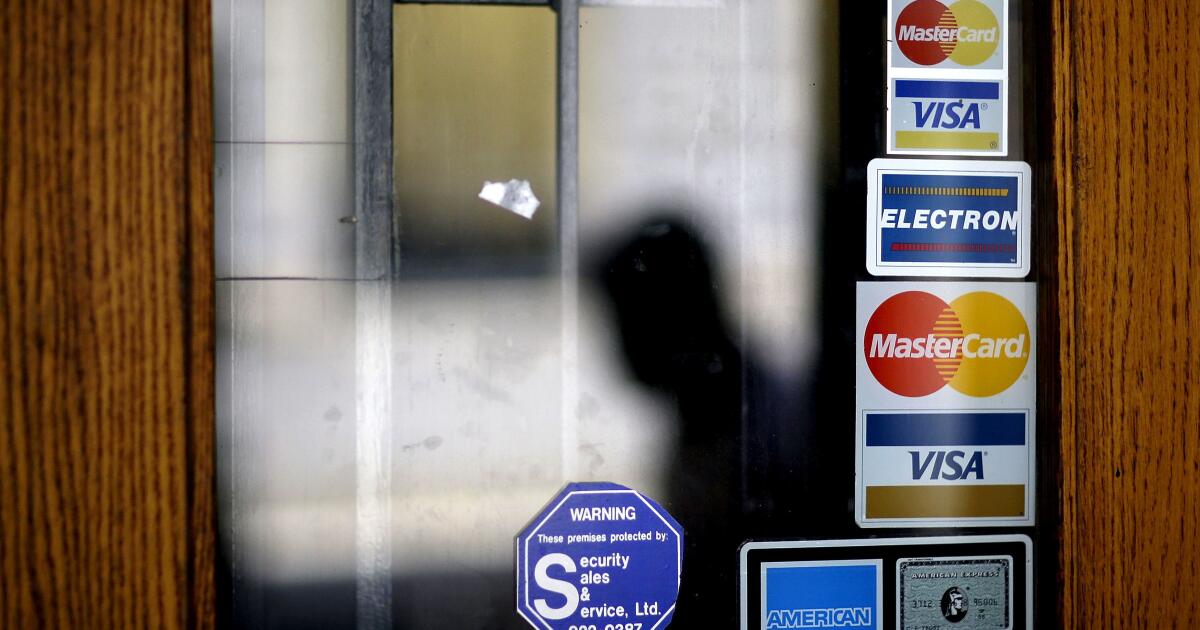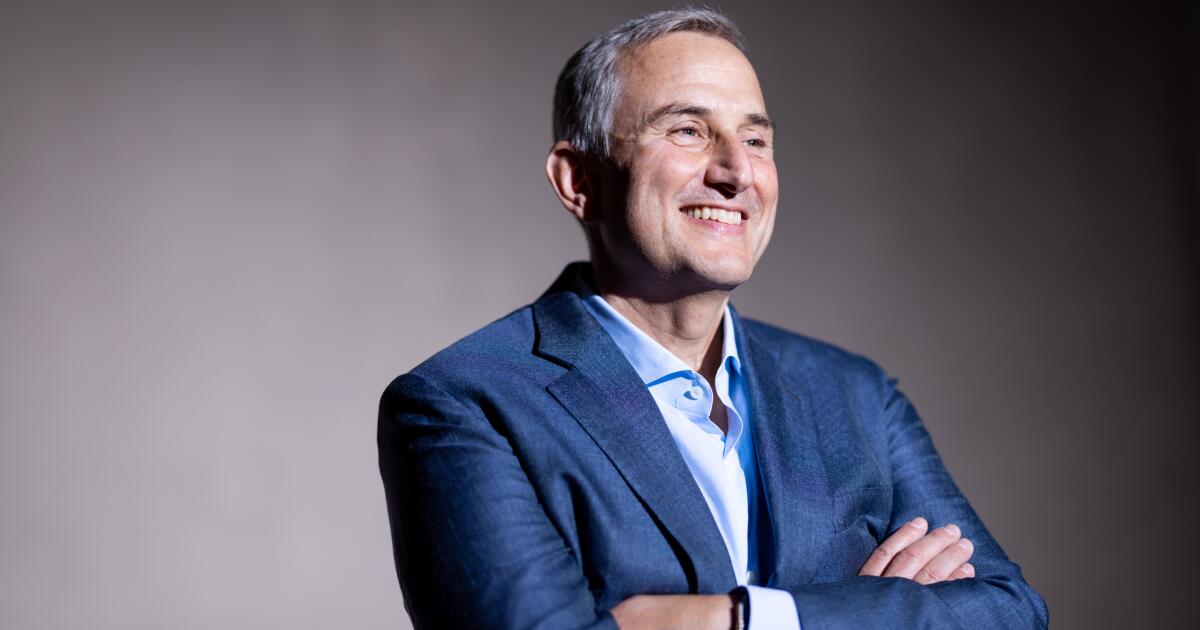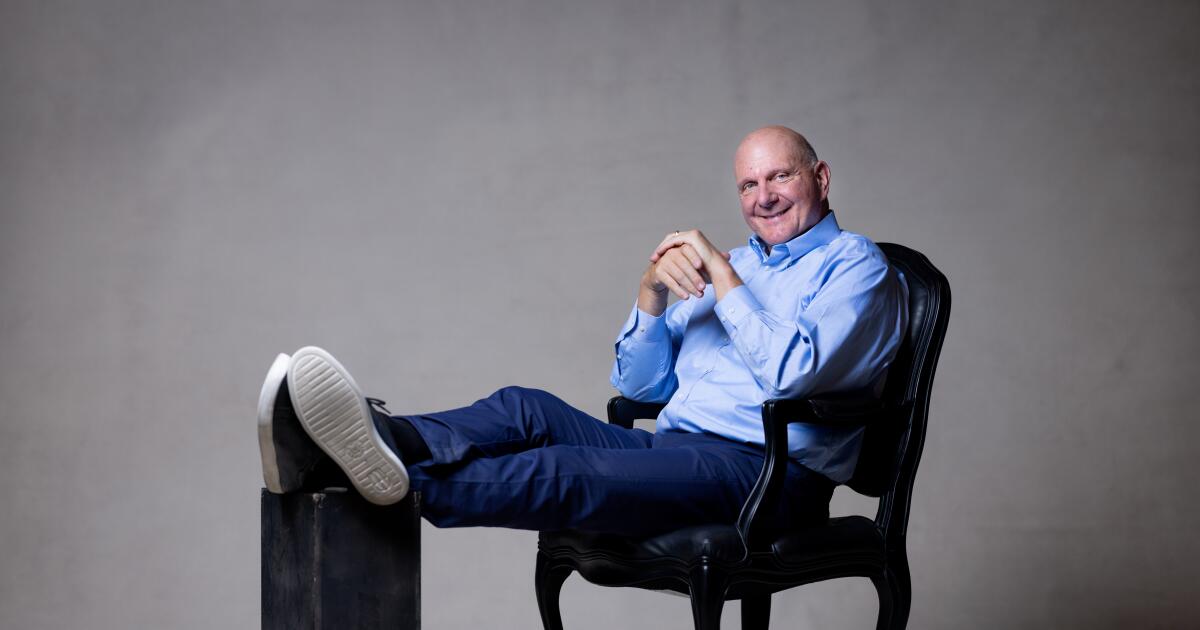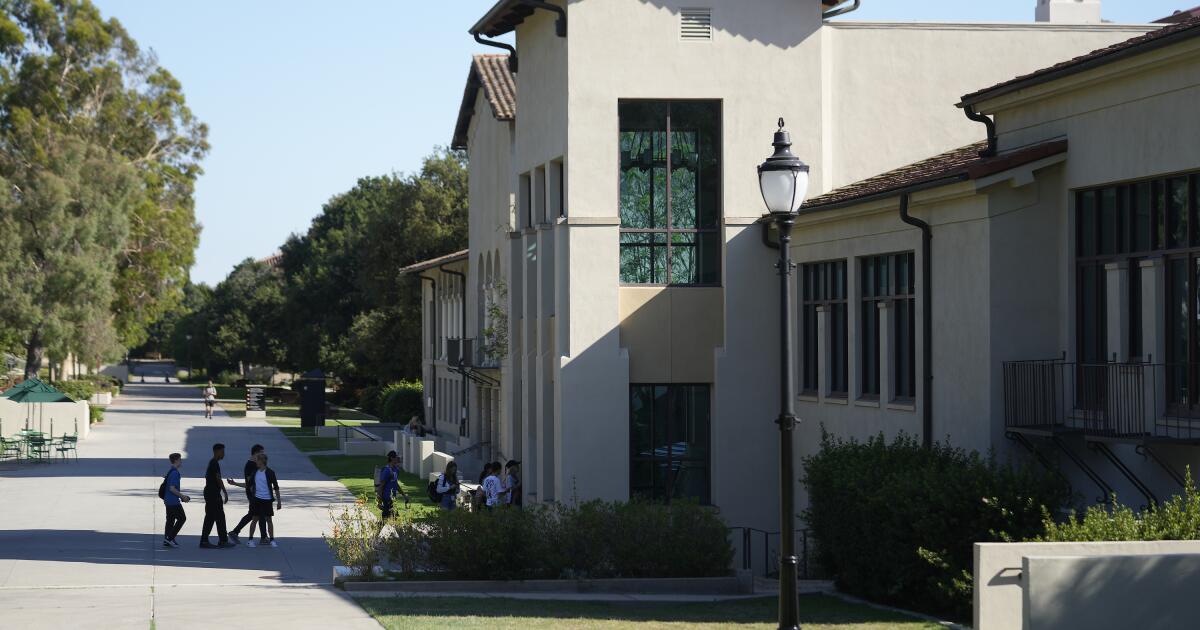Business
As more Californians fall behind in making debt payments, one group stands out

Stubbornly high inflation and interest rates are taking an increasing toll in California as the state experiences rising unemployment and slowing wage gains. And those feeling it the hardest: the largest and perhaps most budget-minded generation of them all.
Millennials, those roughly 28 to 43 years old, are generally thought to be more averse to debt and better savers than earlier cohorts such as Gen X (44 to 59 years old) and baby boomers (60 to 78).
But new data from the California Policy Lab at UC Berkeley show that while consumer debts overall are growing and becoming more difficult to manage for all but the very oldest generation in America, millennials are having the most trouble making their loan payments on time.
In the first quarter, 7.6% of millennial borrowers were at least 30 days late in making monthly payments on their credit card, auto and other loans. That compares with 6% of Gen X, 5.5% of Gen Z (ages 18 to 27) and 3.3% of boomers who fell behind on their loans. The earlier Silent and Greatest generations had even lower delinquency rates.
Unlike for Gen X-ers and boomers, the overall loan delinquency rate among millennials — who make up about one-fourth of California’s population — has now climbed above pre-pandemic levels. And economists worry that financial pressures will only continue to mount, especially with an end to the student loan repayment pause. Among other things, millennials are known for carrying a lot of college loan debt.
“I see no reason to believe that delinquencies aren’t going to be tracking higher,” said Evan B. White, the California Policy Lab’s executive director.
Foreclosures and personal bankruptcies for all ages are still very low by historical standards, as is the percentage of after-tax income that households are spending on making debt payments, another important indicator of financial stress.
Even so, consumers in California and across the country have been taking on more debt in recent quarters, including credit card borrowing. And 30-day delinquencies have been creeping higher — an early warning sign of potential trouble ahead.
Thus far consumer spending, which accounts for most of the nation’s economic growth, has held up well. But many people are feeling the effects of what’s been an extended period of high inflation and interest rates. A pullback by consumers could have a significant effect on the broader economy.
In the Federal Reserve’s annual report on the economic well-being of Americans, also released this week, about two-thirds of adults surveyed said that changes in the prices they paid in 2023 compared with the prior year had made their financial situation worse. And one-fifth of them said inflation had made things much worse.
The Fed report found that 72% of adults were at least “doing OK” financially, similar to the 73% figure in 2022 but well below the recent high of 78% in 2021.
U.S. households continue to benefit from a strong labor market, including solid, if slightly smaller, gains in wages. The nation’s unemployment rate was 3.9% in April, the 27th straight month in which the jobless figure has been below 4% — the longest such stretch since the 1960s.
California’s employment situation, however, has not been as strong. The pace of job gains statewide has lagged behind the nation’s. And California’s unemployment rate of 5.3% last month was the highest in the country, reflecting weakness in key sectors such as entertainment, high tech, and business and professional services. The number of unemployed workers in the state has increased by 164,000 over the last 12 months, according to California’s Employment Development Department.
Meanwhile, wage growth has slowed more in California than for the nation overall — and it’s now running below the rate of inflation, meaning workers’ purchasing power is shrinking.
In the 12 months ending in April, the average hourly earnings for all private employees in California were up 1.4% from the prior year. That’s less than half the rate of both wage growth and inflation for the United States. In contrast, from 2016 to 2022, California employees saw wage gains averaging 3% to 6% per year.
Nationally, aside from student loans, delinquencies on all types of consumer debt have been steadily rising since the end of 2021, according to the New York Fed.
During the first two years of COVID-19, consumers paid down their debts significantly, thanks in part to stimulus checks and other government programs. But since then, credit card delinquencies, in particular, have risen above pre-pandemic levels, and an increasing share of borrowers are maxing out on their plastic, most of them younger adults.
Why millennials seem to be struggling more financially may seem puzzling at first. They’re the best-educated generation and the first to grow up in the digital age. But many millennials also had the misfortune of entering their formative adult lives amid the Great Recession that began in late 2007 and left a trail of job and financial hardships for some years. Saddled with student loans and other debt, they have been slower to move out of their parents’ homes, start families and build wealth compared with earlier generations.
More recently, with home mortgage rates and home prices having soared, many millennials are stuck in apartments and feeling the squeeze of higher rents and prices for certain services that they are likely to need given their stage in life, like day care.
In fact, the Fed’s economic well-being report found that while there was little change for most population groups between 2022 and last year, one notable exception was parents living with their children under age 18. Given that women are having children later, this group would include a disproportionate share of millennials.
“Those are years when you’re moving into higher expenses of buying homes, buying cars and even setting aside money for children’s college,” said Greg McBride, chief financial analyst at Bankrate.com, which has studied generational differences in handling debt. “When we’ve experienced the type of inflation we’ve had, that really puts the squeeze on tight budgets.”

Business
Mark Suster: The face of L.A. venture capital

Mark Suster, photographed at the Los Angeles Times in El Segundo on Sept. 8.
Cancer-fighting robots. AI-powered baby monitors. The future of American shipbuilding.
These are the kinds of startup ideas that get Mark Suster out of bed in the morning, into his Tesla, and down to the Santa Monica offices of Upfront, the venture capital firm he joined 16 years ago.
“There’s that old saying — the future is already here, it’s just unevenly distributed,” Suster said. “My job lets me see where the world’s going five years before the general population.”

Discover the changemakers who are shaping every cultural corner of Los Angeles. This week we bring you The Money, a collection of bankers, political bundlers, philanthropists and others whose deep pockets give them their juice. Come back each Sunday for another installment.
But Suster, 56, didn’t become the face of the L.A. venture capital scene thanks to his day-to-day investing. He got there by throwing a party called the Upfront Summit.
Every year, Suster’s splashy tech conference takes over an iconic L.A. location. One year, it’s at the Rose Bowl. Another year, it’s at a retreat center high in the Santa Monica Mountains. There are zip lines, hot air balloons, and, among the talks with tech founders about software and product development, fireside chats with celebrities, politicians and authors (Lady Gaga, Katy Perry and Novak Djokovic graced the stage this year).
The razzle-dazzle is part of the draw, and Suster clearly relishes his role as emcee (“I was a theater kid — I still love going to the theater,” he said.)
‘My job lets me see where the world’s going five years before the general population.’
— Mark Suster
But the real appeal comes down to cash. Suster’s strategic move was to invite not just venture capital investors, but the people who invest in venture capital investors. Called limited partners, these are the managers of pensions, sovereign wealth funds and other giant pools of money that want to tap into the tech market. By making sure they’re on the guest list, Suster has made the summit one of the easiest places in America for fellow venture capitalists to raise a new fund.

The summit loses Upfront money. When Suster started it in 2012, it cost around $300,000. In 2022, costs hit $2.3 million, Suster said, with a handful of sponsors chipping in to cut the losses. But throwing the premiere professional party in California comes with intangible benefits, like bringing in deals that would otherwise leave out Upfront and other L.A. funds and founders.
The 2024 party was a little scaled back, now that higher interest rates have throttled the fire hose of money that went into venture capital during the last decade. But Suster says that he welcomes the less frothy environment. “I’m having a lot more fun now,” he said, investing in founders “looking to build real businesses.”
More from L.A. Influential
Business
Steve Ballmer: NBA owner in search of a miracle

He sits in a conspicuous baseline seat, where he cheers like nobody’s watching.
The large balding man in long sleeves roars with every splashed basket, gestures with every scintillating pass, face reddening, arms flailing, celebrating so hard he once ripped a hole in his dress shirt.
He could be any die-hard Clippers fan, with one exception.
He owns the team.
Steve Ballmer is the perfect symbol of the power of Hollywood hope, the strength of California dreaming and the resilience of those who come here searching for a miracle.
Discover the changemakers who are shaping every cultural corner of Los Angeles. This week we bring you The Money, a collection of bankers, political bundlers, philanthropists and others whose deep pockets give them their juice. Come back each Sunday for another installment.
Ranking eighth on the Forbes 500 list with an estimated net worth north of $120 billion, Ballmer could afford to buy any sports team in any league.
He chose to buy the Clippers, spending $2 billion in 2014 for a perennial loser and one of five teams to never reach the NBA Finals.
“A team comes up for sale in a city I love that’s near me?” said Ballmer, 68, a former Microsoft executive who lives in Washington state. “You say, ‘OK, but it’s the Clippers,’ and my theory is, you can do anything if you put your mind to it.”
As the richest owner in North American professional sports, he had the wealth and influence to move the bedraggled franchise to a city far away from the big brother Lakers, perhaps even into his adopted hometown of Seattle.
‘It was clear to me, we had to have our own home, our own identity.’
— Clippers owner Steve Ballmer
Yet he doubled down and not only kept the Clippers in town but spent another $2 billion to build his own arena: the glitzy Intuit Dome, which is scheduled to open in October in Inglewood.
“It was clear to me, we had to have our own home, our own identity,” Ballmer said.
Cynics would describe his ownership of the Clippers as charity work, but his real philanthropy has had an even larger impact in the region, with his Ballmer Group investing hundreds of millions of dollars in everything from inner-city businesses to the renovation of 500 Clipper Community Courts in diverse pockets of the city.

“Impacting kids is the kind of thing that pulls at my heart,” Ballmer said. “A fan will tell me that he drove past a Clipper court and I’ll think, that’s really, really, really cool.”
Ballmer is accessible, generous and, most of all, the head cheerleader for a drowned-out swath of a Lakers-owned city.
“I love our die-hard fans,” he said. “I love the culture of c’mon, we have a chip on our shoulder, we’ve got something to prove, we’ve never done it before, c’mon!”
It is a Thursday afternoon early in the 2023-24 NBA season and Steve Ballmer is shouting into the phone, because of course he is, the sound of undying faith, the voice of a true believer, c’mon!
More from L.A. Influential
Business
Occidental trustees vote against divesting from Israel-linked companies

Occidental College’s Board of Trustees voted this week not to divest from companies with ties to Israel, saying the move would further divide the campus and limit freedom of expression.
In a letter to students, faculty and staff on Monday, Occidental Board of Trustees Chair Lisa H. Link acknowledged the devastating effects of the Israel-Hamas war but said that taking a position on a complex geopolitical situation could alienate certain members of the community and undermine its diversity.
“The diversity of community members’ opinions was a compelling reason to refrain from acting on the proposal, as the Board believes a decision in favor of the proposal would be divisive and damaging to the College community,” she said.
The divestment proposal set forth by leaders of the Occidental chapter of Students for Justice in Palestine in May called for the college to identify and disclose any investments in four manufacturing companies that have provided arms and equipment to the Israeli military.
The board said Occidental’s endowment does not include direct investments in any of the four companies.
Indirect investments in the Israel-linked companies make up less than 0.1% of the college’s endowment assets and are managed by third parties that restrict the college’s ability to divest from specific parts of a fund, Link said.
“The Board believes it is not in the best interests of the College, or our current and future students, to jeopardize the endowment by divesting from managed funds that have minimal exposure to certain companies,” she said in the letter.
The board’s vote on the divestment proposal hinged on students taking down their pro-Palestinian encampment, not impeding commencement and not returning to occupy a space on campus without prior approval.
The board held the vote after Occidental’s school year ended in early June.
Matthew Vickers, a co-organizer of the encampment and spokesperson for Occidental’s Students for Justice in Palestine, said he was disappointed by the board’s decision but not surprised.
“Based off of the pressure from Zionist parents and off-campus organizations such as the Brandeis Center and [the Anti-Defamation League] and personal political biases of the Board of Trustees, they caved in to rejecting divestment,” he said.
The Louis D. Brandeis Center for Human Rights Under Law and the Anti-Defamation League filed complaints with the U.S. Department of Education’s Office for Civil Rights in May against Occidental and Pomona College, accusing the universities of permitting discrimination and harassment of Jewish students on their campuses.
Occidental Hillel directed inquiries to Director for Religious and Spiritual Life Susan Young, who declined to comment on the board’s decision not to divest and the alleged antisemitism on campus.
Although the board’s vote came after many students had vacated campus for the summer, Vickers said students who are still in L.A. are planning to hold actions on and off campus to protest the board’s refusal to divest.
On UCLA’s campus, students continue to stage pro-Palestinian protests into the summer, erecting a new encampment on Monday that resulted in about two dozen arrests.
“People are still galvanized and willing to continue the struggle,” Vickers said.
-

 News1 week ago
News1 week agoIsrael used a U.S.-made bomb in a deadly U.N. school strike in Gaza
-

 World1 week ago
World1 week agoRussia-Ukraine war: List of key events, day 833
-

 Politics1 week ago
Politics1 week agoGeorge Clooney called White House to complain about Biden’s criticism of ICC and defend wife’s work: report
-

 Politics1 week ago
Politics1 week agoNewson, Dem leaders try to negotiate Prop 47 reform off California ballots, as GOP wants to let voters decide
-

 World1 week ago
World1 week agoDozens killed near Sudan’s capital as UN warns of soaring displacement
-

 World1 week ago
World1 week agoVideo: U.S. Official Responds to Israeli Strike on a U.N. School in Gaza
-

 World1 week ago
World1 week ago‘Bloody policies’: Bodies of 11 refugees and migrants recovered off Libya
-

 Politics1 week ago
Politics1 week agoEmbattled Biden border order loaded with loopholes 'to drive a truck through': critics















